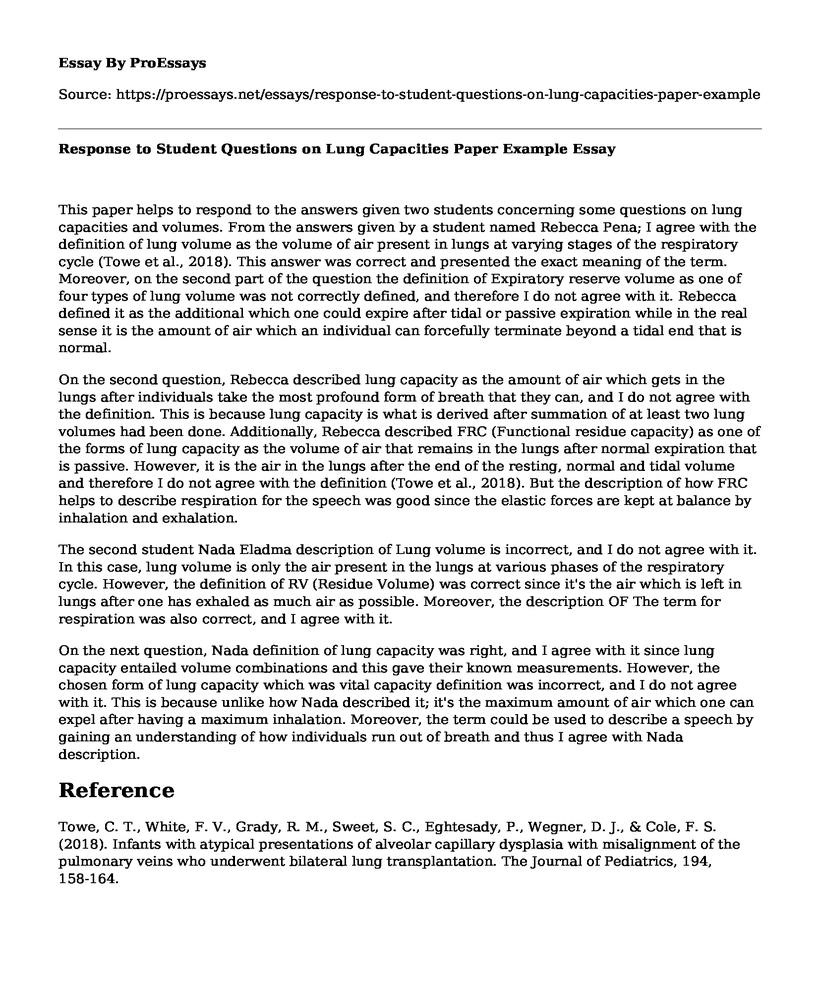This paper helps to respond to the answers given two students concerning some questions on lung capacities and volumes. From the answers given by a student named Rebecca Pena; I agree with the definition of lung volume as the volume of air present in lungs at varying stages of the respiratory cycle (Towe et al., 2018). This answer was correct and presented the exact meaning of the term. Moreover, on the second part of the question the definition of Expiratory reserve volume as one of four types of lung volume was not correctly defined, and therefore I do not agree with it. Rebecca defined it as the additional which one could expire after tidal or passive expiration while in the real sense it is the amount of air which an individual can forcefully terminate beyond a tidal end that is normal.
On the second question, Rebecca described lung capacity as the amount of air which gets in the lungs after individuals take the most profound form of breath that they can, and I do not agree with the definition. This is because lung capacity is what is derived after summation of at least two lung volumes had been done. Additionally, Rebecca described FRC (Functional residue capacity) as one of the forms of lung capacity as the volume of air that remains in the lungs after normal expiration that is passive. However, it is the air in the lungs after the end of the resting, normal and tidal volume and therefore I do not agree with the definition (Towe et al., 2018). But the description of how FRC helps to describe respiration for the speech was good since the elastic forces are kept at balance by inhalation and exhalation.
The second student Nada Eladma description of Lung volume is incorrect, and I do not agree with it. In this case, lung volume is only the air present in the lungs at various phases of the respiratory cycle. However, the definition of RV (Residue Volume) was correct since it's the air which is left in lungs after one has exhaled as much air as possible. Moreover, the description OF The term for respiration was also correct, and I agree with it.
On the next question, Nada definition of lung capacity was right, and I agree with it since lung capacity entailed volume combinations and this gave their known measurements. However, the chosen form of lung capacity which was vital capacity definition was incorrect, and I do not agree with it. This is because unlike how Nada described it; it's the maximum amount of air which one can expel after having a maximum inhalation. Moreover, the term could be used to describe a speech by gaining an understanding of how individuals run out of breath and thus I agree with Nada description.
Reference
Towe, C. T., White, F. V., Grady, R. M., Sweet, S. C., Eghtesady, P., Wegner, D. J., & Cole, F. S. (2018). Infants with atypical presentations of alveolar capillary dysplasia with misalignment of the pulmonary veins who underwent bilateral lung transplantation. The Journal of Pediatrics, 194, 158-164.
Cite this page
Response to Student Questions on Lung Capacities Paper Example. (2022, Dec 10). Retrieved from https://proessays.net/essays/response-to-student-questions-on-lung-capacities-paper-example
If you are the original author of this essay and no longer wish to have it published on the ProEssays website, please click below to request its removal:
- Why Orca Whales Should Not Live in Captivity Essay
- How Inuk Use Seal and Seal Products Essay
- Animal Cognition Is Evolving With the Changes in the Environment Essay
- Sight Sense - Essay Sample
- Genetics in Treating and Developing Cancer Paper Example
- Nature Cries Out: Humanity Must Preserve It for Our Sake - Essay Sample
- Essay on the Interconnectedness of Animal Diseases: An Analysis of Quammen's Spillover







